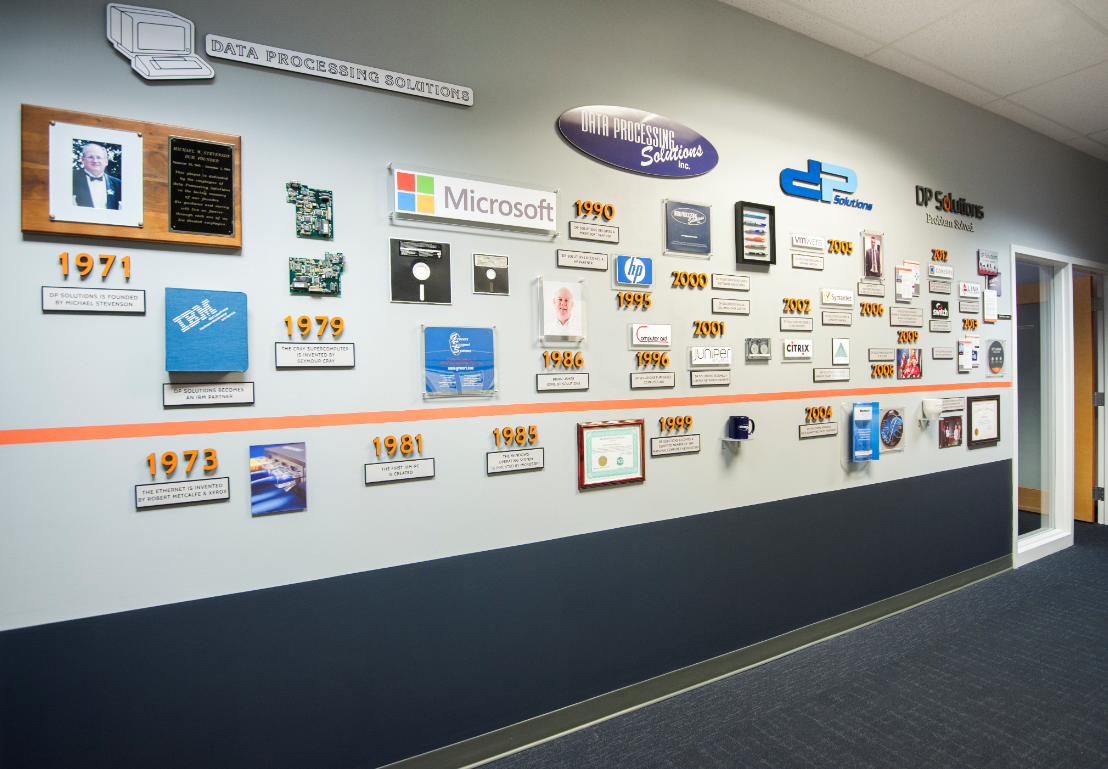IBM. The PC. The rise of Microsoft. Y2K. The cloud.
In 50 years, DP Solutions has seen technology’s milestone moments. They’ve shaped how the Columbia-based company works, and how it serves its clients.
As a managed service provider, the company’s team provides IT functions and even staff to firms throughout the Baltimore-Washington region and internationally that range from small and medium-sized businesses in varying industries to nonprofits and associations to law firms and property managers. In this work, it is a strategic partner to companies.
“Being a strategic partner for our clients is extremely important,” said DP Solutions President Karyn Schell, adding that the key is, “Understanding their business requirements, understanding technology and making sure that we provide them an all-inclusive solution so that we move forward together.”
Through the years, that means the company has also sought to keep up with tech trends, and has led it to evolve with new uses. It’s all on view at a history wall inside the company’s offices.
“Technology has changed, and one thing that has been extremely important to us, how do we make those decisions so we’re doing what we need to do to move forward,” Schell said.
Like many tech companies in the pioneering days, DP Solutions started out of a basement. Michael Stevenson started Data Processing Solutions as an IBM programming shop, offering a range of services across hardware, software, printers and cabling. At that point, most all of the work was customized for a client.
Plenty of evolution followed. The next decade brought the personal computer, popularized by Apple, which changed how technology could be used in a work setting. Floppy disks enabled more portable file transfer. Chief Financial Officer and company owner Brian Usher, who joined the company in 1986 and is its owner, recalls how the conversation shifted to how systems could be networked together, and “talk” to each other.
“More and more, the PC took over,” he said.
Microsoft, which, for the record, started four years after DP Solutions, became the go-to software provider for the systems that ran on them. The company began offering services for Microsoft, which is still its primary focus today. With all of the shifts, it is no longer an IBM business partner.
Events also intervened to shape the company. It acquired the company where Schell then worked (she became company president in 2018), called ComputerAid, in 1996. This helped it prepare for Y2K, adding programmers to prepare systems to make the transition to the jump to 2000, which many thought computer systems weren’t ready for.
Schell recalls a “mad dash,” as technologists thought, “everything is going to come to a screeching halt.”
As it turned out, it didn’t.
With the millennium safely underway and systems intact, the next shift was data centers. Companies previously had servers within their offices. But as they started seeking hosting offsite, DP Solutions added a data center to its Columbia offices. It has since expanded with a presence at multiple data center sites. Today a big focus is around cloud technology, which offers data center capabilities virtually, and it is leveraging Microsoft Azure for clients.
The company’s transition into managed services also came over the last 15 years. A 2009 merger with Advanced Technologies Support Group, DP Solutions allowed it add a 24-7 help desk. The 2017 acquisition of Choice Technologies helped to strengthen its position in this field.

A section of DP Solutions’ hall of history. (Courtesy photo)
The company saw another technology push with the pandemic. Companies needed to shift operations to allow employees to work remotely. Working with companies to provide laptops and make the necessary shifts, DP Solutions hired 13 new employees, and added 27 clients during the year.
While technology shifts have shaped its story, Schell said putting people first has enabled longevity. Along the way, it has centered relationships with customers, leading some to stick around for 30 years.
“We’re in the technology business, but we’re in the customer service business first,” Usher said. “We just happen to support your technology.”
It has also put a focus on its own team. Now with a workforce of 70 people, Schell proudly pointed out that the average tenure for employees is 10 years. The leaders want the team members to push forward with the company.
“I think our people make a huge difference to who we are. We’ve had a great team through our years,” Schell said. “We’ve made sure that we invest in our folks.”
In addition to being a woman-led company, it has grown to a workforce that is 25% women. It stands out in technology — a field that is majority-male. When it comes to addressing those disparities, Schell recalled recent remarks she gave to graduates of the tech-center workforce development program Per Scholas, comparing an ideal world to how talent is evaluated on the popular TV show The Masked Singer.
“If we were all able to put a mask on, are you still able to selected because you were the best person for the job?” she said. “That’s what you want to be.”
When it comes to technology, Schell said the company is continuing to put itself in a position to move forward. There are also challenges that are shaping what it offers for clients. A particular focus now is not only helping companies set up and use their technology, but also keeping attackers from getting in. Security engagement and awareness is particularly top of mind.
The company will officially mark its first 50 years on September 30. With the milestone, it is looking outward at engaging and helping in the community.
“2021,” said Schell, “is our year of giving back.”
Before you go...
Please consider supporting Technical.ly to keep our independent journalism strong. Unlike most business-focused media outlets, we don’t have a paywall. Instead, we count on your personal and organizational support.
Join our growing Slack community
Join 5,000 tech professionals and entrepreneurs in our community Slack today!





